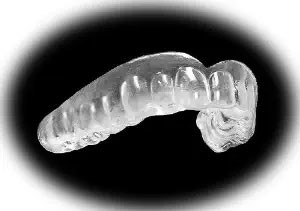Mouth guards not only protect a person’s teeth by shielding them with a tough thermoplastic, they also protect one’s lips and soft mouth tissue, tongue, and jaw. For those who are fashion conscious, the guards come in a variety of colors.
Normally, the guard covers the upper teeth. This plastic feels like rubber, but is even more resilient and flexible. By necessity, the guards add bulkiness inside one’s mouth, so it is important that the guard be as comfortable as possible. There are three styles of mouth guards to choose from: stock, boil to bite, and custom. When choosing, it is important to consider the reason protection for the mouth is needed.
Mouth Guards for Oral Medicine Purposes
Some people have a habit of grinding their teeth during sleep (bruxism). Some people have dental maladies which require protection. For instance, a chipped or broken tooth might be interfering with a tongue or their might be a jaw problem. In such instances, it is recommended to visit the dentist and have him or her create a mold for a bite plate, sometimes known as a mouth splint. Depending on age, because people’s bites change as they grow; over time, new custom-made guards might be needed. Although wearing a guard will not stop someone from grinding their teeth, it will help relieve temporomandibular joint problems (TMJ) and prevent unnecessary enamel wear.
Mouth Guards Used in Sports to Avoid Dental Trauma
However, sports event audiences around the world are probably most familiar with mouth guards because they see athletes wear them. Football players and boxers employ them, but hockey players and skateboarders wear them too. Currently, mouth guards are not mandatory to wear in most other school sports, such as basketball or soccer; however, that may change. The American Academy of Pediatric Dentistry reports that up to a third of all injuries involving school sports sustain some type of oral damage that a mouth guard could have prevented. What’s more, according to the National Youth Sports Foundation, every year, in the United States alone, over five million teeth are lost due to sports-related injuries. This is the reason athletes who are concerned about their smiles sport their guards.
Types of Mouth Guards
Most mouth guards fall into one of three categories: stock (ready made), boil and bite, and custom-made.
Stock
The least expensive is called a stock mouth guard, which only comes in three sizes. These are also the most uncomfortable to wear and offer the least all around protection. The only possible way to make minor adjustments on stock mouth guards is to do some minor trimming with a knife, scissors, or other cutting instrument.
Boil and Bite
Both boil and bite and custom made guards can be molded to specifically fit an individual’s unique teeth bite pattern. Professionally fitting a guard to a person’s bite pattern is done at their dentist’s office and can be expensive. However, there is a way the do-it-yourselfer can avoid the dentist visit. Boil and bite guards can be purchased at retail sporting goods stores for under $40, taken home, and fitted to bite after soaking them in hot water. Although there are companies that recommend individuals make an impression of their bite and then mail it to them so they can custom-make the guard, these products are basically no better than a boil and bite that can be accomplished in one’s own kitchen.
To accomplish creating a boil and bite mouth guard at home:
Boil a pot of water. Take the pot off the stove. Drop the boil to bite guard into it, and let it sit until it softens, 30-55 seconds. Remove the hot guard with tongs or a large fork and let it cool to a tolerable temperature. Place the guard upon the upper teeth and bite down hard for approximately 30 seconds. Take it out of the mouth and run it under cold water to set. If it does not fit comfortably, repeat the process until it does.
Custom-Made
Of the three types of mouth guards: stock, boil and bite, and custom, the ones that are custom-made in the dentist office, while being the most expensive, can offer the most protection and are often the most comfortable to wear.
Athletes wearing braces or who have had expensive dental work done would do well to spend the money and have their dentist make one customized to their needs.
All mouth guards should be cleaned and kept in a container after each use. Check the guard regularly for wear and tear and replace as needed.

